 Edwin Hubble (courtesy of OCIW) |  Milton Humason (courtesy of OCIW) |
 Edwin Hubble (courtesy of OCIW) |  Milton Humason (courtesy of OCIW) |
Work by Edwin Hubble (lived 1889--1953) and Milton Humason (lived 1891--1972) in the 1930's established that each of the spiral nebulae was another huge star system, called a galaxy (from the Greek "galactos", meaning "milk"), outside our own galaxy. Telescopes of sufficient size to have the needed resolution to see individual stars in the other galaxies were used by Hubble and Humason to measure the distances to the galaxies. This chapter covers the galactic systems outside our own and a peculiar group of galaxies that produce a large amount of energy in their centers. The vocabulary terms are in boldface.
The distances between galaxies are large and are often measured in megaparsecs. A megaparsec is one million parsecs (or about 3.3 million light years). For instance, the distance between the Milky Way and the closest large galaxy, the Andromeda Galaxy, is about 0.899 megaparsecs. There was a big controversy in the 1910's and early 1920's over whether the nebulae called galaxies were outside the Milky Way or were part of it. There was so much controversy that the National Academy of Sciences held a debate between the opposing sides in 1920. Those favoring a large Milky Way with the spiral nebulae inside it were represented by Harlow Shapley. Those favoring the spiral nebulae as separate groups of stars outside the Milky Way were represented by Heber Curtis. The Shapley-Curtis debate did not decide much beyond the fact that both sides had powerful evidence for their views.
Edwin Hubble and Milton Humanson set out to resolve the debate by using the largest telescope at the time, the 100-inch telescope on Mount Wilson, to study the large spiral nebula in the Andromeda constellation. Because of its large mirror, the telescope had sufficient resolving power and light-gathering power to spot individual stars in the Andromeda Galaxy. In the mid-1920's they discovered Cepheid variables in the galaxy and used the period-luminosity relation to find that the distance to the galaxy was very much greater than even the largest estimates for the size of the Milky Way. Galaxies are definitely outside the Milky Way and our galaxy is just one of billions of galaxies in the universe. Their discovery continued the process started by Copernicus long ago of moving us from the center of the universe.
Their discovery continued the process started by Copernicus long ago of moving us from the center of the universe. It is ironic that the person who moved the Sun from the center, Harlow Shapley, would be the one to hold fast to our galaxy being the center of the universe. Scientists are humans with all of the greatness and foibles that comes with being human. Despite our prejudices, nature and experiments will always ultimately show us the truth about the physical universe.
In 1936 Hubble put these groups onto a two-pronged sequence that looks like a tuning fork because he thought that the galaxies started out as ellipticals, then changed to spirals and then to irregulars. In this scenario, a galaxy could take one of two paths. It could take the top prong and be a regular spiral where the arms come right out of the galaxy center, or it could take the bottom prong and be a barred spiral with the arms starting from the ends of a bar of gas and stars going through the center. The ellipticals are sub-divided by how round they are and the spirals are sub-divided by how loose their arms are and how big their nucleus is.
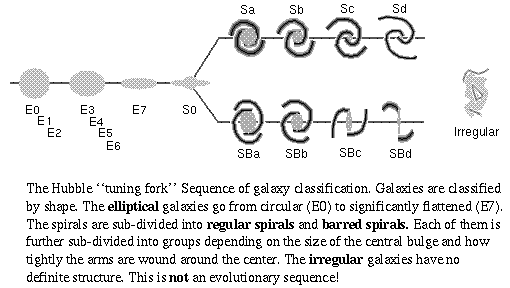
Astronomers now know that it is NOT an evolutionary sequence because each type of galaxy has very old stars. The oldest stars in any galaxy all have about the same age of around 15 billion years. This means that spirals form as spirals, ellipticals form as ellipticals, and irregulars form as irregulars. However, the "tuning fork" diagram is still used to classify galaxies because of its convenience.
Elliptical galaxies are sub-classified according to how flat they are. The number next to the "E" in the tuning fork diagram = 10 · (largest diameter - smallest diameter) / (largest diameter), so an E7 galaxy is flatter than an E0 galaxy. The flattened shape is not due to rotational flattening but to how the orbits are oriented and the distribution of the star velocities. Most ellipticals are small and faint. The dwarf ellipticals may be the most common type of galaxy in the universe (or maybe the dwarf irregulars are). Examples of elliptical galaxies are M32 (an E2 dwarf elliptical next to the Andromeda Galaxy) and M87 (a huge elliptical in the center of the Virgo cluster). The image sequence below starting from from top left and moving clockwise: Messier 32 (E2 satellite of Andromeda Galaxy), Messier 87 (a huge elliptical at the center of the Virgo cluster), Leo I (=UGC 5470, E3 dwarf elliptical in Local Group), Messier 110 (another satellite of Andromeda Galaxy, E6 type)
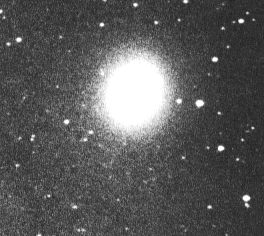 Messier 32: a dwarf elliptical (E2) satellite galaxy of the Andromeda Galaxy. Courtesy of NOAO | 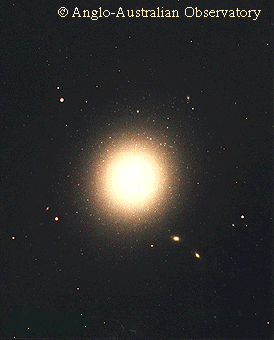 Messier 87: giant elliptical (E1) at the Virgo Cluster's core. It has grown very large by "eating" other galaxies. |
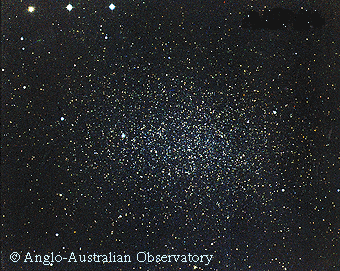 Leo I: dwarf elliptical (E3) in the Local Group. | 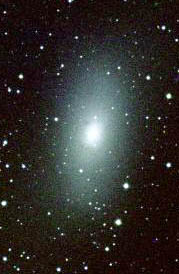 Messier 110: dwarf elliptical (E6) satellite galaxy of the Andromeda Galaxy. Courtesy of Bill Schoening, Vanessa Harvy/REU program/NOAO --- cropped from their M 31 image)) |
Spiral galaxies are sub-classified into "a", "b", "c", and "d" groups according to how loose their spiral arms are and how big the nucleus is. The "a" group spirals have large bulges and very tightly wound spiral arms and the "d" group spirals have almost no bulge and very loose arms. The Milky Way is between the "b" and "c" groups with a possible bar, so it is a Sbc or SBbc-type spiral galaxy. Most spirals are luminous. Some other examples of spiral galaxies are M31 (the Andromeda Galaxy) and M33 (a small spiral in the Local Group).
Some disk galaxies have no spiral arms and are called "S0" ("SB0" if there is a bar) or lenticular galaxies. They are placed at the point in the tuning fork diagram where it brances off to the regular spiral or barred spiral pattern prong. Their gas and dust may been blown away by the galaxy moving quickly through the low-density intergalactic medium (hot, very thin gas between the galaxies) or used up in a rapid burst of star formation.
The sequence of images below starting from top left and moving clockwise: the Andromeda Galaxy (=Messier 31, note M32 above it and M110 below it), Triangulum Galaxy (=Messier 33, small spiral in the Local Group), NGC 2997 (Sc grand-design spiral, may be barred), NGC 3351 (=Messier 95, SBb type), NGC 1365 (SBbc type, note looser arms), NGC 3031 (=Messier 81, Sb type, note it has a larger nucleus than NGC 2997 and tighter arms)
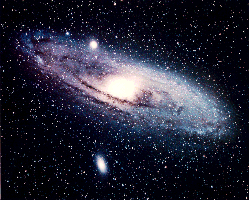 The Andromeda Galaxy (=M 31): a large spiral galaxy (Sb) near the Milky Way. Note M 32 just above it and M 110 below it. Courtesy of Jason Ware | 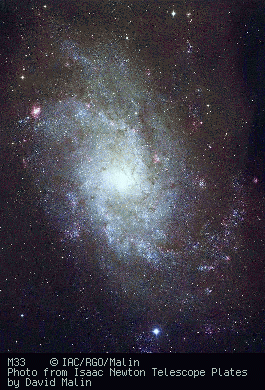 The Triangulum Galaxy (=M 33): a small spiral galaxy (Scd) in the Local Group. |
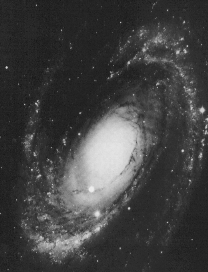 Messier 81: a large spiral galaxy (Sb). Courtesy of NOAO) | 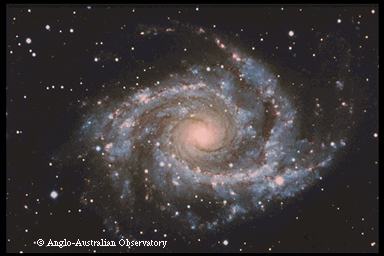 NGC 2997: a large face-on spiral galaxy (Sc). |
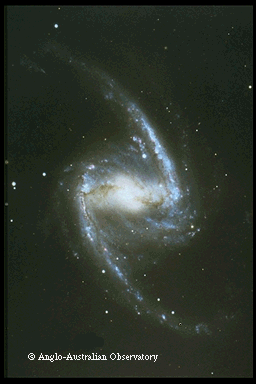 NGC 1365: a barred spiral galaxy (SBbc). | 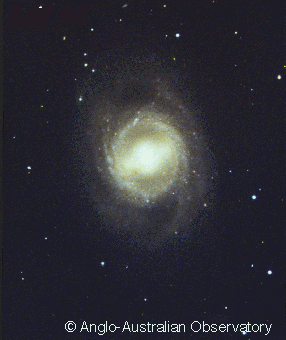 NGC 3351 (=M 95): a barred spiral galaxy (SBb). |
Most irregulars are small and faint. The dwarf irregulars may be the most common type of galaxy in the universe (or maybe the dwarf ellipticals are). The estimates of the number of dwarf irregulars and dwarf ellipticals are based on the proportions of these types of galaxies in nearby groups. The dwarf galaxies far away are too faint to be seen and are, therefore, overlooked in surveys of the sky. Perhaps if the dwarf galaxies were brighter, Hubble would have arranged the galaxies in a different sequence instead of the two-pronged sequence. Examples of irregular galaxies are the Large and Small Magellanic Clouds (two small irregulars that orbit the Milky Way).
The sequence of images below starting from top left: the Large Magellanic Cloud (satellite of Milky Way), the Small Magellanic Cloud (satellite of Milky Way), IC 5152 (irregular in Local Group), NGC 3084 (=Messier 82, starburst irregular in M81 group), NGC 1313 (another starburst galaxy), NGC 6822 (irregular in Local Group).
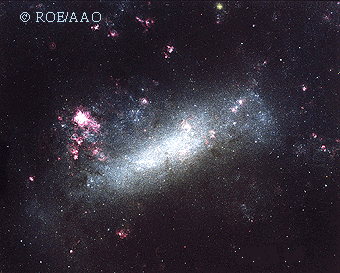 Large Magellanic Cloud: a dwarf irregular satellite galaxy of the Milky Way. | 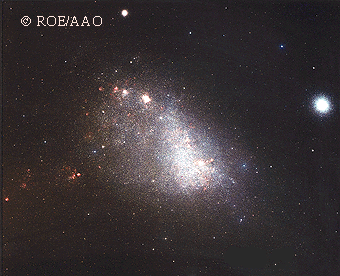 Small Magellanic Cloud: a dwarf irregular satellite galaxy of the Milky Way. |
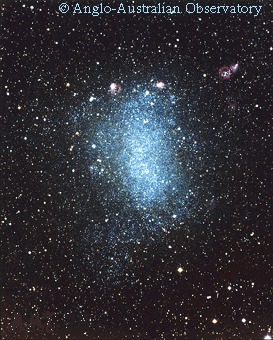 NGC 6822: a dwarf irregular galaxy in the Local Group. | 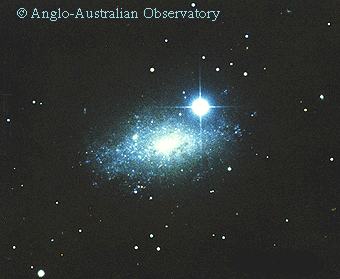 IC 5152: a dwarf irregular galaxy in the Local Group. |
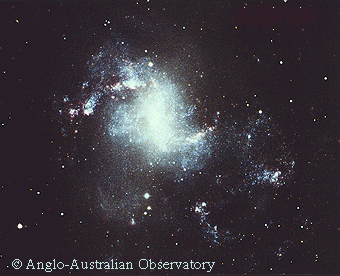 NGC 1313: a starburst galaxy also called a barred spiral galaxy (SBc). | 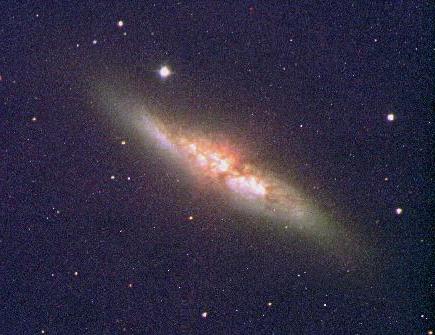 Messier 82: a starburst galaxy. Courtesy of Sven Kohle and Till Credner |
The distribution of galaxies is not perfectly smooth. They clump together into loose groups. If you focus on just the galaxy positions on the sky, you get just a two-dimensional picture. Finding the distances to the galaxies allows you to get a three-dimensional view of the galaxy positions. Three-dimensional maps of the universe have revealed surprisingly large structures in the universe. Galaxies like to group together and those groups, in turn, congregate together.
![]() Tutorial index page
Tutorial index page
Is this page a copy of Strobel's Astronomy Notes?